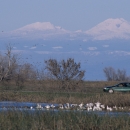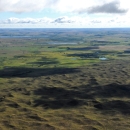Visit Us
Crescent Lake National Wildlife Refuge provides numerous recreational opportunities to thousands of visitors each year. Whether boating, driving, or hiking, visitors enjoy viewing the unique geology and diverse wildlife found here such as the burrowing owl. Regulation of recreational activities allows for public enjoyment of the Refuge while still protecting the wildlife and their habitats.
The communities of Oshkosh and Alliance provide both campgrounds and hotels. We suggest contacting the City of Oshkosh and the Alliance Chamber of Commerce for lodging suggestions. Camping is also available at Nebraska Game and Parks' site, Smith Lake Wildlife Management Area, which is 50 miles north of the Refuge.
Activities
Crescent Lake National Wildlife Refuge offers a variety of visitor activities including hunting, fishing, wildlife viewing, and educational opportunities. One of the best places to start is our self-guided auto tour route. Read on for more details about visitor activities.
Visitor access to the Refuge is via gravel and one lane paved roads. Two-tracked mowed trails provide access within Refuge boundaries. Visitors must maintain the posted speed limit of 35 miles per hour on gravel and pavement. The Refuge is open from sunrise to sunset.
Other Facilities in the Complex
North Platte National Wildlife Refuge was established in 1916 by Executive Order No. 2446 as a “preserve and breeding ground for native birds.” It is located in the Nebraska Panhandle, near Scottsbluff. It was declared a National Wildlife Refuge primarily because of fall concentrations of up to 250,000 mallards, 11,000 Canada geese and bald eagles.
Fort Niobrara National Wildlife Refuge supports an exceptional diversity of plants and wildlife representative of the northern Great Plains and geographic regions east, west, north, and south of here. In the early 1900s, President Theodore Roosevelt and private conservation organizations, such as the National Audubon Society and American Bison Society, were becoming increasingly concerned with the exploitation of wildlife and their habitats on the Great Plains and elsewhere. As a result, an Executive Order was signed on January 11, 1912, establishing Fort Niobrara as a "preserve and breeding ground for native birds." Later that year, the Refuge's purpose was expanded to include the conservation of bison and elk herds representative of those that once roamed the Great Plains.
Valentine National Wildlife Refuge is 71,516 acres and is located in the Sandhills of north-central Nebraska. The Refuge is a unique and ecologically important component of the National Wildlife Refuge System (System) which includes more than 566 National Wildlife Refuges spanning approximately 100 million acres of lands and 750 million acres of oceans in the United States. The native grass prairie and wetlands found here support a diversity of wildlife. Little has changed from historic times. The Refuge was established by Congress in 1935 “as a breeding ground for migratory birds and other wildlife.” The Refuge is home to 270 species of birds, 59 species of mammals, and 22 species of reptiles and amphibians.
Lacreek National Wildlife Refuge lies in the shallow Lake Creek valley on the northern edge of the Nebraska Sandhills and includes 16,410 acres of native sandhills, sub-irrigated meadows, impounded fresh water marshes, and tall and mixed grass prairie uplands. The Refuge serves as an important staging area for migrating waterfowl, sandhill cranes, shorebirds, and neotropical migrants. Providing critical wintering habitat for the high plains trumpeter swan population is a primary goal.
John W. and Louise Seier National Wildlife Refuge is found in north-central Nebraska, as a sanctuary among the Sandhills. The Sandhills region is the largest remaining tract of mixed and tallgrass prairie in North America. The Seier Ranch was originally homesteaded by John and Louise Seier’s grandparents in the mid-1800's. John and Louise Seier did not have any immediate family, but did have a love of wildlife and an interest in preserving wildlife, they donated their 2,400 acre working cattle ranch to U.S. Fish and Wildlife Service in October of 1999. Because the Refuge is so new to the System, it remains closed to the public at this time. There is no projected date for the opening of the Refuge, however, a date will be established upon the completion of a management plan.
Locations
The Refuge is open from sunrise to sunset.
Visitor access to the Refuge is via gravel and one lane paved roads. Two-tracked mowed trails provide access within Refuge boundaries. Visitors must maintain the posted speed limit of 35 miles per hour on gravel and pavement.
To enter from the south, go north from Oshkosh, NE on West Second Street for 28 miles. Follow Refuge signs along this route.
From Alliance, NE, go east on State Highway 2 to about one quarter mile east of Antioch. Go south, following Refuge signs.
From Ellsworth, go west on Highway 2 about 8 miles then go south, following Refuge signs.
Plan to drive about an hour after leaving highways from the north or south.
Please click here for general Refuge location.





